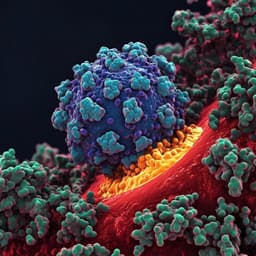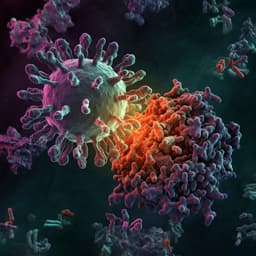
Medicine and Health
Vaccination of SARS-CoV-2-infected individuals expands a broad range of clonally diverse affinity-matured B cell lineages
M. Chernychev, M. Sakharkar, et al.
This groundbreaking study reveals how vaccination of individuals previously infected with SARS-CoV-2 leads to intense and diverse antibody responses. Researchers isolated 459 spike-specific monoclonal antibodies, demonstrating their neutralizing ability against various viral variants, proving the efficacy of mRNA vaccines in enhancing immune response among convalescent individuals. Conducted by Mark Chernychev and colleagues.
~3 min • Beginner • English
Introduction
The rapid global spread of SARS-CoV-2 underscored the need to understand qualitative aspects of humoral immunity to emerging viruses, including neutralizing antibody activity and durability of protection. Infected individuals mount rapid IgG and neutralizing responses primarily targeting the spike receptor-binding domain (RBD), with early response magnitude correlating with disease severity. Following control of viral replication, serum antibody levels wane as short-lived plasma cells decline, but affinity maturation persists in germinal centers for months, improving the quality of the memory B-cell (MBC) compartment. mRNA vaccines (Moderna mRNA-1273 and Pfizer/BioNTech BNT162b2) induce strong protection against severe disease, yet antibody titers decline over time and boosting is needed to sustain protection against symptomatic infection. The emergence of variants of concern (VOCs) such as Delta and Omicron that partially evade prior immunity complicates durable protection. Individuals with prior infection followed by vaccination (hybrid immunity) exhibit higher antibody titers and broader neutralization against VOCs than vaccination alone. The study aims to dissect, at clonal resolution, how infection-induced B-cell responses evolve over time and how vaccination recalls and expands these affinity-matured lineages, addressing whether the recall response is constrained or broadly polyclonal.
Literature Review
Prior work shows that SARS-CoV-2 infection generates neutralizing antibodies predominantly targeting the RBD, with response magnitude linked to disease severity. Antibody titers wane post-infection, but germinal center-driven affinity maturation continues for months, enhancing MBC quality. mRNA vaccines elicit robust protection; however, antibody levels decrease over time, necessitating boosters. VOCs such as Beta, Delta, and Omicron exhibit partial to marked escape from prior infection- or vaccine-elicited antibodies, reducing neutralization sensitivity. Multiple studies report that hybrid immunity (infection followed by vaccination) produces higher titers and broader neutralization breadth than vaccination alone. Earlier serological analyses provided overall titers and breadth, but fewer studies examined qualitative clonal evolution of MBCs and plasma cells over extended periods. Structural and repertoire studies have documented biased IGHV gene usage for certain RBD-directed public antibody classes, while S2-directed responses can be cross-reactive with endemic betacoronaviruses (e.g., HKU1). These findings set the context for studying longitudinal B cell clonal evolution and recall after vaccination.
Methodology
Study design: Two individuals infected with index SARS-CoV-2 in October 2020 were sampled longitudinally and received a single mRNA vaccine dose approximately five months post-infection. Peripheral blood mononuclear cells (PBMCs) and serum were collected at acute infection (1–14 days), convalescent (~32–37 days), pre-vaccination, and post-vaccination (7–10 days) timepoints. Ethics approvals were obtained in Sweden and at Dartmouth–Hitchcock Hospital; informed consent was secured.
Single B-cell isolation: PBMCs were stained to sort antibody-secreting cells (ASCs) at acute and post-vax timepoints and memory B cells (MBCs) at the pre-vax timepoint, using multicolor flow cytometry and SARS-CoV-2 spike protein tetramers. Single cells were sorted into lysis buffer for downstream amplification.
mAb generation: Variable gene segments were amplified by nested RT-PCR, cloned via yeast homologous recombination into IgG1 expression vectors, and transformed into Saccharomyces cerevisiae. Recombinant IgGs were expressed in yeast cultures, purified by protein A affinity chromatography, and Fabs were generated by papain digestion when needed.
Binding and kinetics: Apparent affinities were measured by biolayer interferometry (BLI) on an Octet HTX, using anti-human capture sensors and 1:1 binding models for analysis.
Neutralization assays: SARS-CoV-2 spike-pseudotyped MLV and VSV systems were used to quantify neutralization. Serially diluted mAbs were incubated with pseudoviruses bearing spikes from index, Beta, Omicron BA.1, and other variants, followed by infection of ACE2-expressing cell lines. Luciferase readouts after incubation enabled calculation of IC50 via four-parameter nonlinear regression.
Serology: ELISAs measured serum binding to S-2P spike proteins, generating EC50 values from logistic fits; area under the curve analyses were performed for titers.
Repertoire sequencing and genotyping: IgM libraries (acute timepoint) were prepared to infer personalized IGHV genotypes and for lineage tracing. IgG libraries were prepared from acute, convalescent, and post-vax PBMCs. Libraries were sequenced (Illumina MiSeq 2×300 bp). Personalized immunoglobulin germline alleles were inferred to improve accurate V(D)J assignment and SHM calculations. Quality control included detection and removal of chimeric sequences.
Lineage tracing and analysis: Rep-seq VDJ sequences were processed with IgDiscover and custom pipelines (including FAD for diversity-focused analysis). Clonotypes were defined by shared V and J allele assignments and identical HCDR3 nucleotide sequences; lineages were clustered using an HCDR3 nucleotide match cutoff. When multiple light chains appeared in mAb-defined lineages, sub-lineages were assigned based on Levenshtein distances. Maximum-likelihood phylogenetic trees were constructed using muscle/MAFFT alignments and FastTree; visualization used ggtree. Somatic hypermutation (SHM) levels were compared across timepoints. Statistical tests included Mann–Whitney U and Wilcoxon signed-rank tests.
Data and code: Rep-seq data were deposited with SciLifeLab Data Centre (restricted access upon request). Software included IgDiscover v1.0.0 and custom scripts available via GitLab and Zenodo; HMM code for CDR germline identification is publicly available.
Key Findings
- Isolated 459 spike-binding monoclonal antibodies (mAbs) from two convalescent donors later vaccinated (~5 months post-infection): 223 from IM3694 and 227 from IM3695.
- mAbs targeted all major spike subdomains (RBD, NTD, S2), with S2-binding antibodies dominating overall; IGHV usage was broad and highly similar between donors, indicating inter-donor consistency.
- Thirty-one mAbs displayed neutralization with IC50 < 0.4 µg/mL against at least one SARS-CoV-2 variant. Four mAbs (ADI-6774d, ADI-6713s, ADI-6718s, ADI-6785t) potently neutralized Omicron BA.1 with IC50 < 0.02 µg/mL; three of these also neutralized BA.2.75 but not BA.5.
- Vaccination of previously infected individuals substantially boosted serum binding and neutralizing titers against index virus and VOCs compared to vaccination alone.
- Thirty-three non-neutralizing mAbs cross-reacted with HCoV-HKU1 spike, predominantly isolated during acute infection, suggesting boosting of pre-existing cross-reactive MBCs from prior endemic betacoronavirus exposure. These cross-reactive mAbs exhibited significantly higher SHM than SARS-CoV-2-specific mAbs from the same acute timepoint (Mann–Whitney U, P = 1.261e-5).
- Longitudinal IgM/IgG repertoire sequencing and lineage tracing revealed extensive diversification and accumulation of SHM in SARS-CoV-2 spike-binding lineages from acute infection through the five months preceding vaccination, yielding a highly polyclonal MBC pool.
- Lineage analyses showed multiple RBD-directed neutralizing lineages present at acute infection (in ASCs) and re-detected post-vaccination (as reactivated MBC-derived sequences), indicating distinct differentiation fates and efficient recall by vaccination.
- Comparisons of SHM indicated increases between acute and post-vax timepoints, but SHM levels were similar between pre-vax MBC-derived mAbs and their post-vax traced variants (7–9 days after vaccination), consistent with recall of already affinity-matured MBCs without additional rapid GC maturation in that short interval.
Discussion
The study addresses how infection-primed B cell responses evolve and are recalled by vaccination. Broad IGHV gene usage and targeting of multiple spike subdomains underscore a highly polyclonal humoral response to SARS-CoV-2. Longitudinal lineage tracing demonstrates that, over the months following infection, spike-specific B cell lineages continue to diversify and accumulate SHM, building a robust memory pool. Upon vaccination around five months post-infection, this diversified memory is efficiently recalled, leading to marked increases in serum binding and neutralizing titers and expansion of multiple distinct lineages, rather than an oligoclonal recall. The presence of four highly potent Omicron BA.1-neutralizing mAbs isolated prior to Omicron’s emergence illustrates that conserved epitopes can be targeted through infection-initiated and vaccine-recalled maturation. However, observed escape by BA.5 highlights antigenic evolution and the limits of cross-variant neutralization for some lineages. The enrichment of HKU1 cross-reactive, highly mutated S2-directed antibodies during acute infection supports the notion that SARS-CoV-2 infection can boost pre-existing endemic coronavirus memory, whereas mRNA vaccination did not robustly recall certain S2-focused specificities, suggesting epitope availability and exposure history shape immunodominance. Collectively, the findings show that hybrid immunity leverages a broad, affinity-matured MBC repertoire to generate potent responses upon boosting, informing vaccine strategies that aim to preserve breadth amid viral evolution.
Conclusion
This work provides a clonal-resolution view of how SARS-CoV-2 infection primes a broad, diverse, and affinity-matured memory B cell repertoire that is efficiently recalled by subsequent mRNA vaccination. Isolation and characterization of 459 mAbs revealed broad IGHV usage, multiple spike subdomain specificities, and 31 neutralizing mAbs including four with potent Omicron BA.1 activity. Longitudinal repertoire sequencing and lineage tracing showed extensive SHM accrual between infection and vaccination and demonstrated that boosting recalls diverse lineages without evident restriction to an oligoclonal response. These insights help explain the heightened magnitude and breadth observed in hybrid immunity and highlight conserved epitopes that can inform next-generation vaccine design. Future work should expand cohort size, include later post-boost timepoints to assess potential GC re-entry, incorporate tissue-resident MBC compartments, and evaluate how heterologous versus homologous antigen exposures and dosing intervals shape B cell immunodominance and breadth against evolving variants.
Limitations
- Small sample size of two deeply profiled donors limits generalizability.
- Blood-only sampling likely underestimates the full diversity of tissue-resident memory B cells.
- Lack of later post-vaccination timepoints precludes assessment of potential recruitment of infection-induced IgG+ MBCs back into germinal centers after boosting.
- Potential technical artifacts (e.g., PCR chimeras) required rigorous filtering; residual artifacts could still affect repertoire inferences.
- Variant panel did not include all emerging sublineages; neutralization escape (e.g., BA.5) indicates that breadth is context-dependent.
- Some methodological descriptions suggest inconsistencies in vaccine product exposure; precise vaccine details could influence immunological outcomes.
Related Publications
Explore these studies to deepen your understanding of the subject.







